Overwatered palm tree: how to save it from dying and make it flourish again
Welcome to our post on palm tree overwatered! We all know palm trees are a common choice for giving our gardens and landscapes a touch of the tropics. Their tall, thin trunks and thick, green fronds have earned these stately plants their reputation. However, palm trees might experience issues if they are not given the correct care, just like any other plant. Overwatering is one frequent concern that can harm palm palms.
Overwatering occurs when a plant receives more water than it can utilize and can cause several issues for palm trees. In this article, we’ll look at the signs of overwatering in palm trees, why it occurs, and what you can do to stop it. You can maintain your palm trees healthy and growing by being aware of the symptoms and causes of overwatering.
Therefore, whether you’re interested in palm trees or want to understand more about this widespread issue, keep reading!
Here are the key takeaways about overwatered palm trees:
- Overwatering causes yellowing/browning leaves, wilting, soft/rotting trunk, fungal growth, slowed growth, damp soil, tilting, and pests.
- Palm trees need proper watering based on species, age, size, environment, and soil type.
- Check soil moisture before watering using finger test at 1-2 inch depth.
- Water young palm trees deeply but infrequently, in morning. Mulch around base.
- Underwatering causes yellowing/wilting leaves and slowed growth.
- Palm trees need deep, thorough watering 1-2 times per week typically.
- After repotting, wait a few days before watering and then check soil moisture.
- Common watering mistakes include overwatering, underwatering, incorrect frequency, and improper watering technique.
- Can save an overwatered palm tree by stopping watering, removing standing water, examining roots, fertilizing, and monitoring recovery.
- With proper moisture monitoring and watering technique, palm trees can flourish.
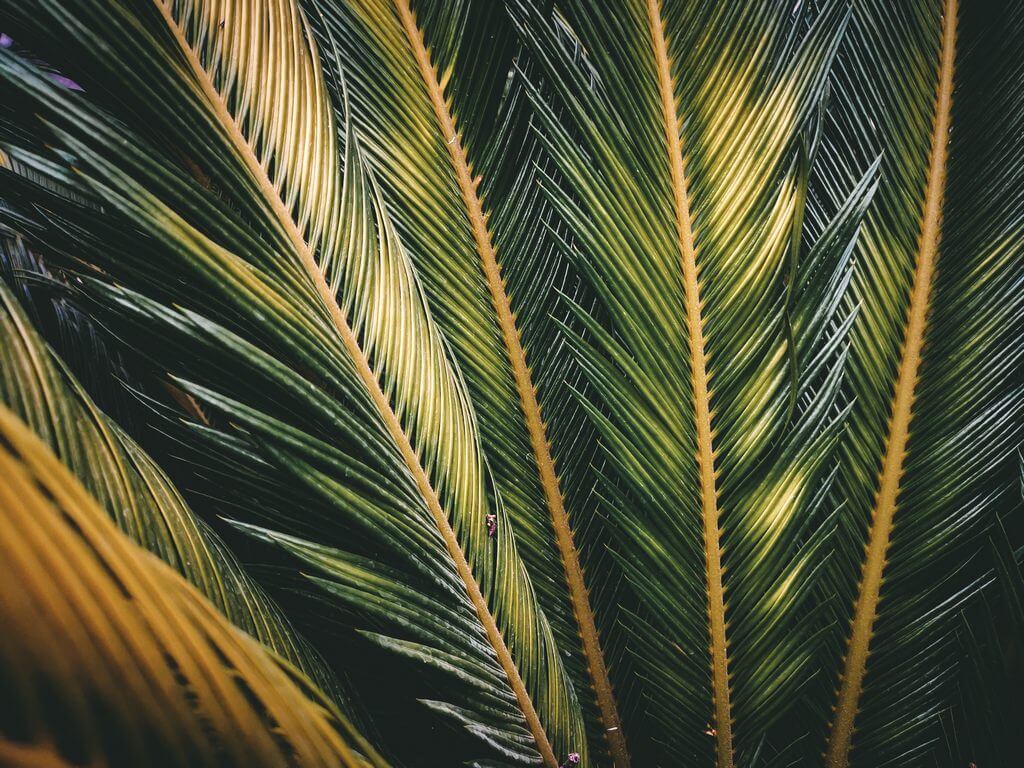
A Overwatered palm tree can be detected if there are several indicators. These consist of the following:
Yellowing or browning of leaves
Palm trees’ leaves can become yellow, brown, wilt, or limp from overwaterred. This is frequently a warning that the roots are starting to decay because they aren’t getting enough oxygen.
Leaf drop or wilting
Wilting is another typical symptom of palm tree overwatering. Overwatered palm tree might result in the plant being soggy and unable to absorb nutrients properly. The palm tree may begin to wilt or droop as a result.
Trunk soft or decaying
A palm tree’s trunk that has grown soft or decaying indicates that the tree is receiving too much water. The tree may eventually die if the trunk rots from too much moisture.
Fungal/fungus growth
Inadequate watering might encourage the development of fungus-like root rot. This can be a severe problem for palms since it may kill the plant by destroying the roots. The plant may succumb to root rot, leaving behind black or brown blisters on the roots.
Slowed growth
A palm tree that receives too much water may develop slowly. This is due to the possibility that too much rain will hinder the tree’s ability to absorb nutrients from the soil. Growth stunting may occur if your palm tree receives too much water. As a result, the plant will develop more slowly and aggressively.
Damp soil
If the ground around a palm tree is perpetually moist and soggy, the tree is likely receiving too much water. The excessive dampness may make it difficult for the roots to acquire the oxygen they require to survive. One of the most apparent symptoms of overwatering is persistently wet soil. If the soil surrounding your palm tree is continually moist, you may be watering your palm tree too frequently.
Palms swaying to one side
If a palm tree begins to sway to one side, it can indicate that the tree has been overwatered. The tree may tilt due to the soil becoming too soft from the abundant precipitation.
Slow or no new growth
An overwatered palm tree may only produce new development is growing. The tree’s ability to develop fresh leaves and branches may be hampered by excessive dampness.
Pests
Excessive watering can provide an atmosphere that pests like snails and slugs find attractive. These pests may indicate that the palm tree is being overwatered and can harm it.
It’s crucial to remember that different conditions, such as pests, illnesses, or soil difficulties, might also bring these symptoms. As a result, getting the issue professionally diagnosed is always advisable before attempting to cure it.
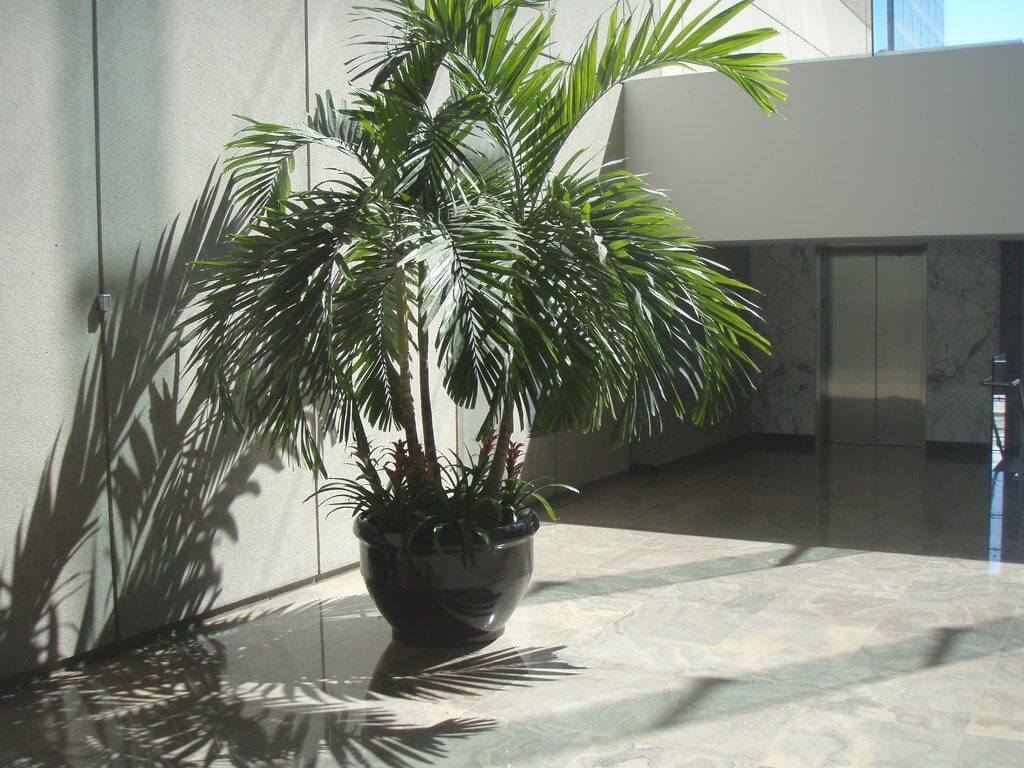
How Often Should Watering a Palm Tree?
Palm trees are low-maintenance plants, but they do need moisture to grow. The frequency when you should water a palm tree depends on various factors, including the palm species, the age and size of the tree, the environment in which it is growing, and the type of soil it is planted.
Most palm trees require watering once or twice per week, depending on the weather and soil conditions. During hot, dry months, you may need to water your palm tree more regularly, but you may be able to lessen the watering frequency during cooler, wetter periods.
To determine whether to water your palm tree, it is advisable to check the moisture content of the soil by putting a finger approximately two inches into the soil. If the soil at this depth feels dry, it’s time to water the tree. If the soil feels moist, you can hold off on watering for a few days.
It is also essential to water your palm tree thoroughly rather than lightly, as this will help ensure that the water reaches the tree’s roots and receives the hydration it requires. Avoid getting the tree’s foliage wet, which might lead to fungal infections.
Additionally, mulching around the palm tree’s base will help conserve soil moisture and reduce watering frequency.
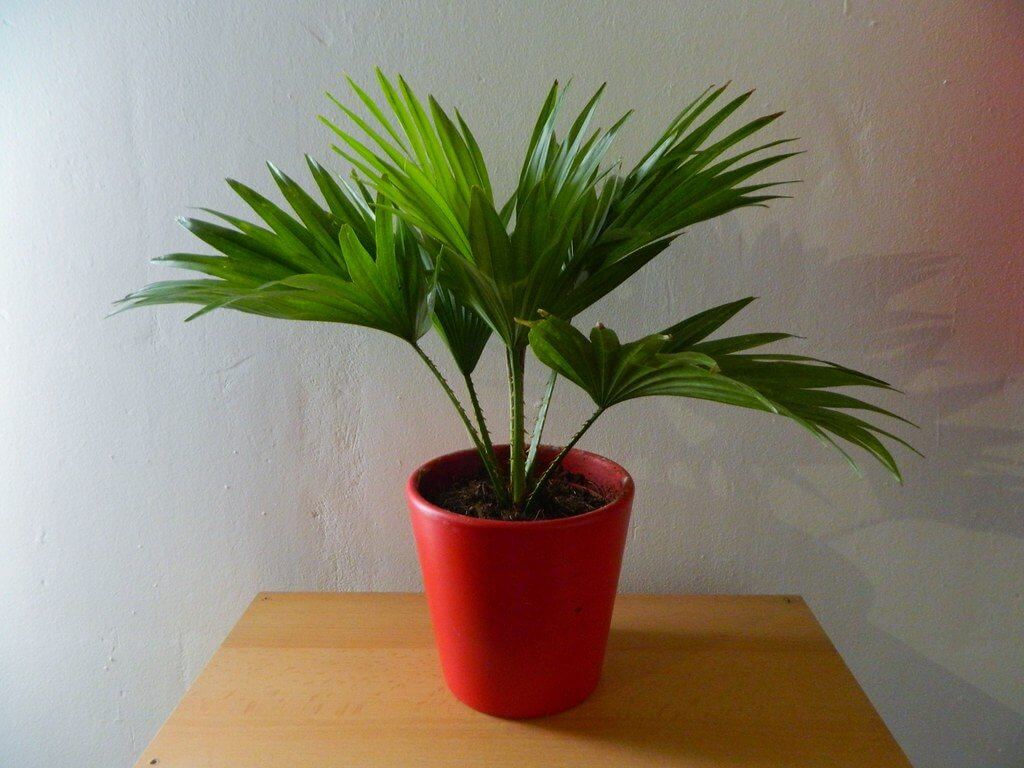
Overwatered Palm Tree: How to water young palm tree
Young palm palms have shallow root systems and are more susceptible to over- and under-watering than adult trees. Please pay close attention to the watering demands of young palm trees to ensure that they receive the ideal amount of moisture for their development. Here are some watering guidelines for young palms:
- To guarantee that the water reaches the tree’s roots, it is essential to deeply water young palm trees instead of lightly watering them. This may prevent the tree from becoming stressed by a lack of moisture.
- Before watering your young palm tree, it is a good idea to check the soil’s moisture content by inserting a finger or two into the soil. It is time to water the tree if the soil at this depth feels dry. Watering can be delayed for a few days if the soil feels damp.
- Water the tree in the morning. Watering young palm trees in the morning allows the soil to dry out over the day, which can help prevent fungal infections.
- Avoid overwatering young palm palms; overwatering can cause root rot and other problems. Check the soil’s moisture content before watering the tree, and avoid watering it if the soil is already moist.
- Mulch around the base of the tree: Mulching around the bottom of the tree can assist in preserving soil moisture and minimize the watering frequency.
Following these guidelines ensures that your baby palm tree receives the necessary amount of moisture to grow and thrive.
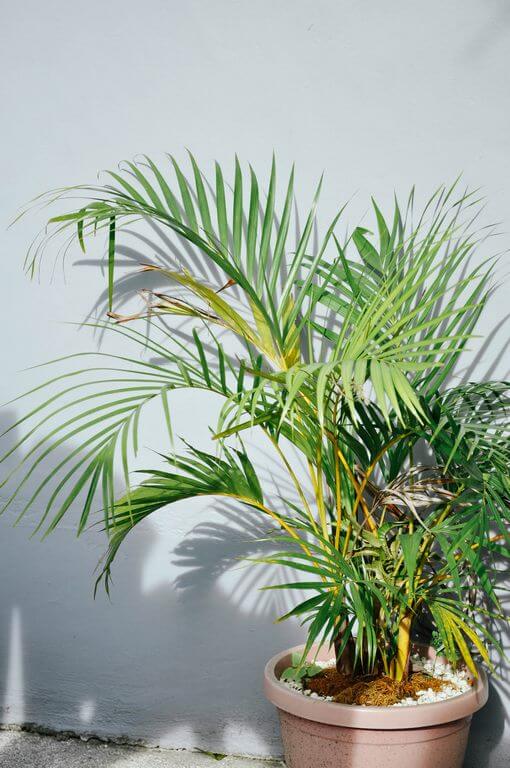
How to know if your palm tree needs watering
There are several significant indicators that a palm tree needs watering:
1. Yellowing or wilting foliage: If the leaves on your palm tree begin to yellow or wilt, it may indicate that the tree is not receiving enough water.
2. Dry soil: If the ground around the palm tree’s base feels dry, it may indicate that it needs watering.
3. If your palm tree is not developing as quickly as it should, it may need to receive more water.
To assess if your palm tree needs to be watered, it is a good idea to check the soil’s moisture level by putting your finger approximately one to two inches into the soil. If the soil at this depth feels dry, it’s time to water the tree. If the soil feels moist, you can hold off on watering for a few days.
In addition to monitoring the soil moisture level, observing the palm tree’s general appearance is prudent. If the tree’s leaves are yellowing or drooping and it is not growing as quickly as it should, it may require additional water.
By paying attention to these symptoms and consistently watering your palm tree, you can ensure that it remains healthy and reaches its full growth potential.
How much water does it take to water a palm tree, so it doesn’t cause overwatering?
Like what I am saying above, The quantity of water a palm tree requires will vary depending on the tree’s species, age, and size, the environment in which it is growing, and the kind of soil it is placed in. Depending on the weather and soil conditions, most palm plants typically require watering once or twice a week.
It is a good idea to check the soil’s moisture level by sticking a finger about an inch or two into the soil to gauge how much water your palm tree requires. It’s time to water the tree if the soil feels dry at this depth. Wait a few more days before watering if the soil still seems damp.
In order to guarantee that the water gets to the tree’s roots and that it receives the necessary hydration, it is crucial to deeply water your palm tree as opposed to just misting it. Water the tree carefully and evenly to prevent overwatering, being careful not to dampen the leaves of the tree as this might cause fungus infections.
Watering your palm tree to a depth of around 6 inches wet is recommended. This should provide the tree with the hydration it requires without overwatering it. Consult a local nursery or a gardening professional for more detailed advice if you need clarification about how much water your palm tree requires.
Can we save the overwatered palm tree?
It is possible to save an overwatered palm tree, but it will depend on how bad the overwatering was and how healthy the tree is overall. Try to save a palm tree that has been overwatered by following these steps:
1. Stop watering the palm tree and let the soil totally dry out before taking any further action. This will aid in lowering soil moisture levels and stop additional harm to the roots.
2. Eliminate any standing water: It’s crucial to eliminate any standing water that may be present around the tree’s base. The roots may suffer additional harm from standing water, which also keeps them from accessing the oxygen they require.
3. Examine the palm tree’s root system: if any of them are damaged or infected, they may need to be removed and replaced. If you are unsure that you can complete this process safely because it can be tricky and sensitive, it is advisable to call in a professional arborist.
4. Fertilize the tree: To aid the palm tree’s recovery from the overwatering, fertilize it once the soil has dried out and the root system has been examined. Pick a fertilizer designed especially for palm trees, and then follow the directions on the label.
5. Keep a close eye on the tree: Make sure the palm tree is recuperating by keeping a tight check on it. You should consult a certified arborist if you discover any other symptoms of stress or deterioration.
When attempting to save a palm tree that has been overwatered, keep in mind that patience is critical. The tree’s recovery could take some time, and it won’t happen at all. However, you may give the tree the best chance of surviving by carefully following the preceding instructions and taking good care of it.
When Should Watering a Palm Tree After Repotting?
It’s crucial to take extra care not to overwater a palm tree after relocating it to a new pot. Here are some guidelines for watering your palm tree after repotting it:
It is best to wait a few days before watering the palm tree after transplanting it into a new pot. This will allow the tree to adjust to its new environment and the roots to establish themselves.
Instead of watering the palm tree on a predetermined schedule, it is best to check the soil moisture regularly. Feel the soil for moisture by inserting your finger about an inch deep. If the soil is dry, the tree should be watered. If the soil is still moist, wait to water again for a few days.
When you water the palm tree, make sure to water it thoroughly. This involves watering the tree until the soil is thoroughly saturated and water is dripping from the bottom of the container. Deep watering encourages the tree’s roots to grow deeper into the soil, thereby securing it in its new container.
Keep the soil moist but not soaked. If the soil completely dries out, the palm tree may experience drought stress. Conversely, if the soil remains too wet for too long, the tree’s roots may rot.
By adhering to these guidelines, you can help your palm tree flourish in its new container. Remember to be patient and observe the tree closely to ensure that it is receiving the necessary amount of water.
What are the common mistakes in watering palm trees
Several frequent mistakes can be made when watering palm trees:
It is essential to prevent overwatering palm trees, as they are susceptible to root rot if overwatered. Insert your finger approximately an inch into the earth to determine if a palm tree requires watering. If the soil feels dry, watering is necessary.
Underwatering: On the other hand, it is essential to prevent under-watering palm trees since they will become agitated and may die if they do not receive enough water.
The frequency of watering depends on the kind of soil, the weather conditions, and the size of the palm tree. Depending on the requirements, palm trees should be watered once or twice each week.
Incorrect watering technique: It is essential to utilize a watering technique that allows water to reach the root zone of the palm tree. This may involve the use of a drip irrigation system or deep, infrequent watering.
Failure to mulch: Mulch can assist in preserving soil moisture, which is advantageous for palm trees. Be sure to apply a layer of mulch around the tree’s base, but avoid piling it against the trunk.
By avoiding these errors, you can assist in guaranteeing that your palm trees receive the essential care and hydration they require to flourish.
Types of Indoor Palm Tree
Many species of palm trees are well-suited to being kept as houseplants and can grow quickly with low maintenance, such as low watering frequency. Below are a few good examples:
1. areca palm: The areca palm is a well-liked houseplant because it requires minimal maintenance and grows in a variety of environments. It is characterized by leaves that are feathery and bright green, and it can attain a height of several meters.
2. Kentia palm: The slender, arching fronds of the Kentia palm make it a desirable houseplant. It grows slowly but is resistant to dim lighting.
3. lady palm: You can fit more of this compact palm tree, commonly called the “lady palm,” into a limited amount of room. Easy to care for and sporting delicate fan-shaped leaves.
3. The Parlor Palm is a well-liked option for indoor plant life due to the fact that it is a relatively small palm tree and can thrive in low-light environments. It’s easy to take care of and has long, narrow leaves.
4. sago palm: As a result of its resilience and ability to thrive in dim lighting, the sago palm is frequently used as an indoor plant. The plant grows slowly but needs little attention once established.
In order to take advantage of the aesthetic and functional benefits of indoor palm trees, it is vital to select the suitable variety for your home and provide it with the care it needs.
Conclusion about overwatered palm tree
Overwatered palm tree or Overwatering is a common problem that can harm palm trees by causing yellowing or browning of the leaves, wilting, soft or decaying trunk, fungal growth, slowed growth, damp soil, swaying to one side, slow or no new development, and attracting pests. It is critical to water palm trees properly, taking into account the species, age and size of the tree, the environment, and the type of soil, and how to avoid overwatering by checking soil moisture and using the appropriate watering frequency and method. To prevent overwatering, use mulch and consider using a drip irrigation system or watering deeply and infrequently.
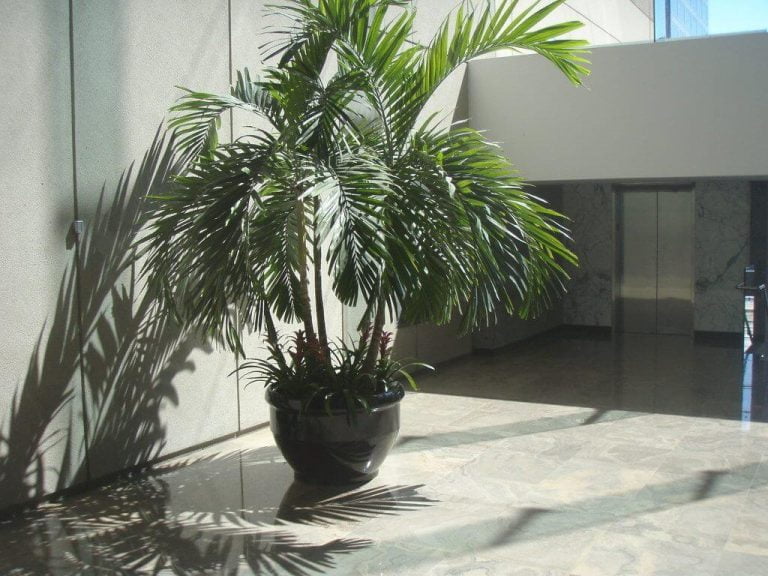
1 thought on “How to Save Overwatered Palm Tree”
Comments are closed.